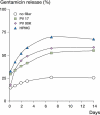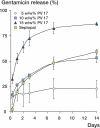Concepts for increasing gentamicin release from handmade bone cement beads
- PMID: 19916680
- PMCID: PMC2823325
- DOI: 10.3109/17453670903389782
Concepts for increasing gentamicin release from handmade bone cement beads
Abstract
Background and purpose: Commercial gentamicin-loaded bone cement beads (Septopal) constitute an effective delivery system for local antibiotic therapy. These beads are not available in all parts of the world, and are too expensive for frequent use in others. Thus, orthopedic surgeons worldwide make antibiotic-loaded beads themselves. However, these beads are usually not as effective as the commercial beads because of inadequate release kinetics. Our purpose was to develop a simple, cheap, and effective formulation to prepare gentamicin-loaded beads with release properties and antibacterial efficacy similar to the commercially ones.
Methods: Acrylic beads were prepared with variable monomer content: 100% (500 microL/g polymer), 75%, and 50% to increase gentamicin release through creation of a less dense polymer matrix. Using the optimal monomer content, different gel-forming polymeric fillers were added to enhance the permeation of fluids into the beads. Polyvinylpyrrolidone (PVP) 17 was selected as a suitable filler; its concentration was varied and the antibiotic release and antibacterial efficacy of these beads were compared with the corresponding properties of the commercial ones.
Results: Gentamicin release rate and the extent of release from beads prepared with 50% monomer increased when the PVP17 content was increased. Beads with 15 w/w% PVP17 released 87% of their antibiotic content. This is substantially more than the gentamicin release from Septopal beads (59%). Acrylic beads with 15 w/w% PVP17 reduced bacterial growth by up to 93%, which is similar to the antibacterial properties of the commercial ones.
Interpretation: A simple, cheap, and effective formulation and preparation process has been described for hand-made gentamicin-releasing acrylic beads, with better release kinetics and with antibacterial efficacy similar to that of the commercial ones.
Figures





Comment in
-
Self-mixed antibiotic bone cement: western countries learn from developing countries.Acta Orthop. 2009 Oct;80(5):505-7. doi: 10.3109/17453670903317122. Acta Orthop. 2009. PMID: 19916679 Free PMC article. No abstract available.
References
-
- Blaha JD, Nelson CL, Frevert LF, Henry SL, Seligson D, Esterhai JL, Jr, Heppenstal RB, Calhoun J, Cobos J, Mader J. The use of Septopal (polymethylmethacrylate beads with gentamicin) in the treatment of chronic osteomyelitis. Instr Course Lect. 1990;39:509–14. - PubMed
-
- Bowyer GW, Cumberland N. Antibiotic release from impregnated pellets and beads. J Trauma. 1994;36((3)):331–5. - PubMed
-
- Buchholz HW, Engelbrecht H. Depot effects of various antibiotics mixed with Palacos resins. Chirurg. 1970;41((11)):511–5. - PubMed
-
- Bühler V. 4th ed. 1999. Kollidon® Polyvinylpyrrolidone for the pharmaceutical industry, BASF.
-
- Dacquet V, Varlet A, Tandogan RN, Tahon MM, Fournier L, Jehl F, Monteil H, Bascoulergue G. Antibiotic-impregnated plaster of Paris beads. Trials with teicoplanin. Clin Orthop. 1992;((282)):241–9. - PubMed
MeSH terms
Substances
LinkOut - more resources
Full Text Sources
